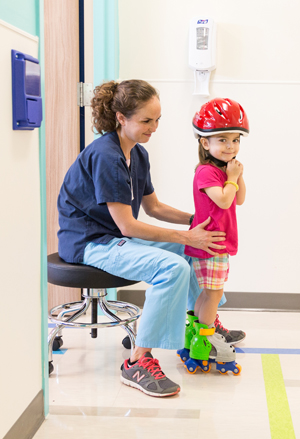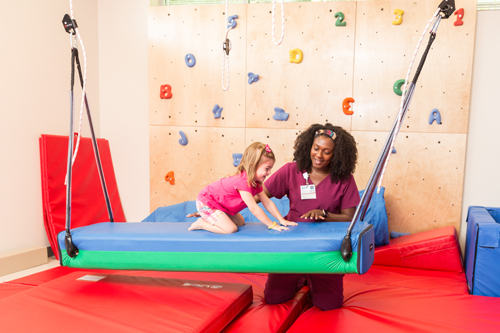Specialists
and therapists treat Tenley on the Peninsula
Four-year-old Tenley Fredrickson of Yorktown shares a seat with her sister, Piper, whispering and giggling as she waits for her
physical therapy
 session at the
CHKD Health Center at Lightfoot in Williamsburg. She’s wearing a yellow bracelet today, which means she’s in a so-so mood according to her mom, Bree, who uses a three bracelet system – green, yellow and red – to help Tenley show how she is feeling each morning. But when Anna Lloyd, a CHKD physical therapist, comes out to greet her, Tenley hops up, takes Anna’s hand and heads to the gym with a smile. Watching her jump and play, it is hard to imagine that just two years ago Tenley could barely stand.
session at the
CHKD Health Center at Lightfoot in Williamsburg. She’s wearing a yellow bracelet today, which means she’s in a so-so mood according to her mom, Bree, who uses a three bracelet system – green, yellow and red – to help Tenley show how she is feeling each morning. But when Anna Lloyd, a CHKD physical therapist, comes out to greet her, Tenley hops up, takes Anna’s hand and heads to the gym with a smile. Watching her jump and play, it is hard to imagine that just two years ago Tenley could barely stand.
Around the time of Tenley’s second birthday, Bree noticed her daughter’s left knee had become a little misshapen. Within three weeks Tenley could no longer walk or even stand in her crib. “Seeing your toddler in pain like that is heartbreaking. We didn’t know what was causing this drastic change, and we were scared,” says Bree.
In October of 2014, Tenley was referred to CHKD and diagnosed with
juvenile idiopathic arthritis or JIA. JIA is arthritis that affects children before the age of 16 and causes symptoms that can include joint swelling, redness, stiffness and pain. It is an autoimmune disease in which a child’s immune system causes inflammation in the joints.
Approximately 300,000 children in the U.S. have some form of arthritis. JIA, the most common, has six subtypes based on the number of affected joints and other accompanying conditions. Tenley has oligoarticular JIA, defined as arthritis in four or fewer joints. Tenley’s JIA currently affects her left knee, right wrist and two fingers. She takes medication twice a day to reduce inflammation and relieve pain. She also receives home injections every week to suppress the joint inflammation caused by her JIA.
“Most people don’t associate arthritis with young children, and they may not realize how different it is from adult arthritis,” says Bree. “A variety of stressors can set off her symptoms, and she can be in a lot of pain. But Tenley is a trouper, she handles this challenge – even the weekly shots – with such courage and determination.”
If left untreated, JIA can cause permanent damage to joints and interfere with bone growth, so Tenley’s multidisciplinary care includes visits to the
CHKD Health and Surgery Center at Oyster Point for appointments with
Dr. Cassyanne Aguiar, a pediatric rheumatologist, every 12 weeks. “I love caring for kids like Tenley,” says Dr. Aguiar. “And since no two children are affected by the disease in exactly the same way, my work as a pediatric rheumatologist is always interesting.” Children with JIA make almost 700 visits to CHKD each year.
In addition to medication,
physical and occupational therapies prevent joint stiffness, maintain dexterity and build muscle strength to better support weak joints. In addition to her weekly physical therapy sessions at Lightfoot, Tenley participates in regular occupational therapy sessions at the
CHKD Health Center at Butler Farm in Hampton.
 Turning the hard work of therapy into an hour of fun and progress is what CHKD therapists do best. To help Tenley exercise her finger joints, she scooters around an obstacle course on her belly, using her fingers to steer in the right direction. “In occupational therapy we do activities like this to focus on range of motion and flexibility in Tenley’s hand and wrist,” says Ashley Williams, a CHKD occupational therapist. Physical therapy sessions include kid-friendly activities too, like roller-skating and throwing a basketball, to help Tenley with issues like endurance, balance and pain management. “We want to make sure Tenley is able to play and enjoy life with the least amount of restriction possible,” says Anna.
Turning the hard work of therapy into an hour of fun and progress is what CHKD therapists do best. To help Tenley exercise her finger joints, she scooters around an obstacle course on her belly, using her fingers to steer in the right direction. “In occupational therapy we do activities like this to focus on range of motion and flexibility in Tenley’s hand and wrist,” says Ashley Williams, a CHKD occupational therapist. Physical therapy sessions include kid-friendly activities too, like roller-skating and throwing a basketball, to help Tenley with issues like endurance, balance and pain management. “We want to make sure Tenley is able to play and enjoy life with the least amount of restriction possible,” says Anna.
Children with oligoarticular JIA are also at a particularly high risk for chronic eye inflammation or uveitis, which can lead to vision loss. So Tenley makes regular visits to
Dr. Eric Crouch, a pediatric ophthalmologist at CHKD, to keep a close watch on her vision. She also sees
CHKD specialists in allergy, otolaryngology and pulmonology – receiving her care at the CHKD Health and Surgery Center at Oyster Point.
“We’re so grateful to be able to get all of the care Tenley needs so close to home,” says Bree. “We know families who travel six hours just to be seen by a pediatric rheumatologist. We are lucky Tenley is able to see all of her specialists and therapists right here on the Peninsula at facilities specifically designed just for kids. We’ve even made a trip or two to the CHKD Urgent Care at Tech Center in Newport News.”
Children with JIA, like Tenley, can be considered in remission after a period of time without any symptoms or additional affected areas. Unfortunately, JIA symptoms can continue into adulthood and flare ups, commonly triggered by infection, stress or intense physical activity, can occur at any time. So Tenley will continue to be followed by her CHKD care team for many years to come.
With the help of her family and CHKD, Tenley will have many green bracelet days ahead. “Managing Tenley’s illness takes a lot of work, but we have seen a huge improvement in her condition over the last two years thanks to the great care she receives at CHKD,” says Bree. “It gives me hope for her future. A healthy future.”